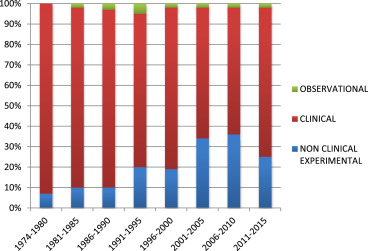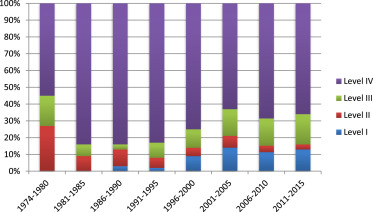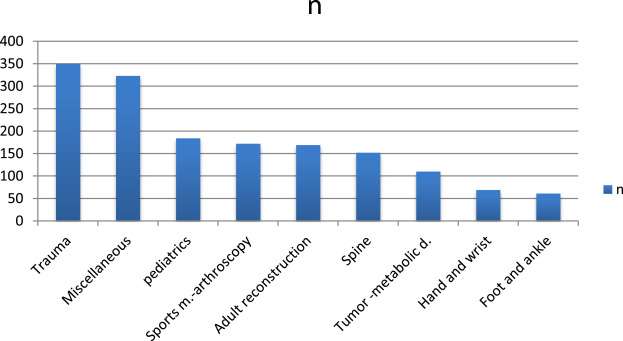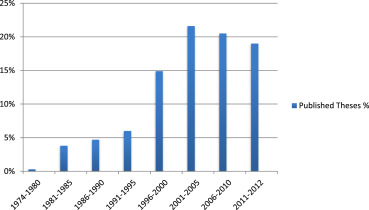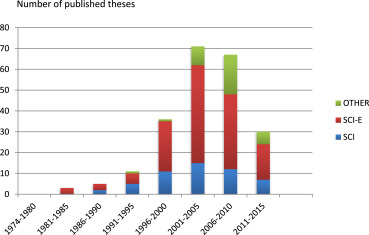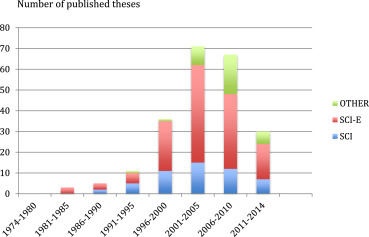Abstract
Background
The aim of this study was to present characteristics and publication patterns of studies arise from orthopedic theses obtained from National Thesis Center; database in terms of publication years, study types, topics, level of evidence between 1974 and 2014.
Methods
Firstly, National Thesis Center database was searched for orthopedics and Traumatology theses. The theses, which their summary or full text were available were included in the study. The topics, study types and quality of study designs were reviewed. Then theses were searched in the PubMed database. Journals of published theses were classified according to category, scope and impact factors of the year 2014.
Results
1508 theses were included into the study. Clinical studies comprised 71,7% of the theses, while 25,6% of the theses were non-clinical experimental and 2,7% of the theses were observational studies. Clinical studies were Level I in 8,6% (n = 93) and Level II in 5,8% of the theses (n = 63). A total of 224 theses (14,9%) were published in the journals indexed in PubMed database from 1974 to 2012. Fifty-two (23,2%) were published in SCI; 136 theses (60,7%) were published in SCI-E journals and 36 theses (16%) were published in other Journals indexed in PubMed.
Conclusion
The quantity and quality of published theses need to be improved and effective measures should be taken to promote quality of theses. Theses from universities and Training hospitals which did not allow open access, and; incomplete records of the National Thesis Center database were major limitations of this study.
Keywords
Orthopaedics ; Publication patterns ; Theses ; Level of evidence
Introduction
A thesis is the first scientific step of a postgraduate student. Publication of a thesis as a scientific article in the final makes the thesis worthy.1 Also scientific activity of institutions or universities can be measured by amount of publications, impact factors of the journals, and amount of citations.2
A thesis is a critical component of postgraduate residency program in Turkey. Thesis preparation requires much time and effort and brings understanding of the scientific literature as well as the ability to independently and analytically think. A thesis prepared at the end of residency program is accepted as a ‘Masters thesis' in Turkey. However the last two years of medical education is also accepted as a postgraduate programme in a non-thesis form, but it is not possible to go on to a doctorate degree. In order to avoid the loss of effort and time, it is important to publish thesis in a significant journal.
The aim of this study was to present characteristics and publication patterns of studies arise from orthopedic theses obtained from National Thesis Center database in terms of publication years, study types, topics, level of evidence between the years 1974 and 2014.
Methods
In the first phase, the National Thesis Center database was searched for articles related to orthopedics and traumatology between the years of 1974–2014. Unfortunately theses from universities and training hospitals of Heath Ministry which did not allow open access to theses from their departments, and incomplete records in the National Thesis Center database limits this study. The search results included a summary or the full text of the publications. Two independent researchers conducted analysis with disagreements resolved by discussion or a third one. Theses were evaluated according to years, study types, and topics. Topics of theses were categorized into 10 main subheadings; trauma, pediatrics, sports-arthroscopy, adult reconstruction (knee, hip, ankle), spine, tumor (tumor, metabolic diseases, AVN, infection), hand-wrist, foot-ankle, shoulder-elbow and miscellaneous (basic science, practice management, osteoarthritis and other issues). Research methodologies were grouped under three main headings to include clinical, non-clinical experimental and observational. Clinical study designs were classified based on the American Academy of Orthopedic Surgeons' Levels of Evidence and Grades of Recommendations System.3 Level I studies consisted of high-quality randomized controlled trials, while Level II studies consisted of lesser-quality randomized controlled trials and prospective comparative studies. Level III studies were made up of case-control and retrospective comparative studies and Level IV was composed of case series with no controls. Non-clinical experimental studies were grouped under five main headings - animal research, cell culture (in vitro tests), biomechanical, cadaveric and movement analysis.
In the second phase, theses were searched for in the PubMed database. All theses were evaluated and checked for potential matches with a specific thesis. Journals of published theses were classified according to category, scope and impact factor of the year 2014. Journal citation reports of the ISI web of knowledge and National Library of Medicine4 ; 5 were used for journals scope and impact factor. Distribution of published thesis by year of publication and annual rates of increase and decrease were described with separate tables and graphs.
Thesis owners were also searched on the web with respect to their credentials. Those credentials were also confirmed on the website of their respective institutions. All thesis owners with the appropriate academic degrees were considered academicians. The mean publication numbers of academicians and non-academicians in the PubMed database were also determined.
All data was transferred to Microsoft Excel and analyzed using SPSS 15.0. Descriptive analysis was primarily used. The clinical data were presented as number, percent and mean. The distributions of data were subject to certain year intervals.
Results
Search results accounted for 1520 theses between the years 1974 and 2014. The abstract or full text of 12 theses could not be accessed, so they were excluded from the study, leaving 1508 theses that had an accessible abstract or full text (full text: 573 (38%); abstract: 935 (62%)). The number of theses demonstrated an increasing trend according to years (see Fig. 1 ). 71,7% (n = 1081) of the theses were clinical, 25,6% (n = 386) were non-clinical experimental and 2,7% (n = 41) were of observational study designs. Distribution of the study designs according to years is exhibited in Fig. 2 . Non-clinical experimental studies showed an increase during 2006–2010 and, subsequently, a rapid drop from 2011 to 2014. 8,6% (n = 93) of the clinical studies were Level I, 5,8% (n = 63) were Level II, 12,9% (n = 139) were Level III and 62,1% (n = 669) were Level IV based on the American Academy of Orthopedic Surgeons' Levels of Evidence and Grades of Recommendations System. Quality of study designs of the clinical studies according to years is described in Fig. 3 . Level I studies rose till 2014. Level II studies showed a rapid decrease from 1981 to 1985 and undulation afterwards.
|
|
|
Fig. 1. Study types of theses according to years.
|
|
|
|
Fig. 2. Quality of study designs of clinical studies.
|
|
|
|
Fig. 3. Distribution of thesis topics.
|
As indicated in Fig. 4 , the most common topic was trauma (n = 349, 23,1%), followed by miscellaneous (basic science, practice management, osteoarthritis and rehabilitation medicine) (n = 323, 21,4%) and pediatrics (n = 184, 12,2%).
|
|
|
Fig. 4. The distribution of publications pattern of theses.
|
1394 theses were prepared between the years 1974–2012 and a total of 224 theses (16%) were published in journals indexed in the PubMed database. The years after 2012 were not included because of the fact that getting a citation requires approximately two years after publication. The first published thesis was related to a lower extremity prosthesis, prepared by Halit Özyalçın in 1982, and published in the Journal of Prosthetics and Orthotics International in 1989.6Fig. 5 details the rates of published theses according to years. A rapid increase is seen up to the period between 2001 and 2005, with a slight decrease thereafter. Table 1 shows the distribution of published journal articles in terms of frequency, scope and impact factor. Acta Orthopaedica et Traumatologica Turcica, with 63 published theses (28,1%), and Knee Surg Sports Traumatol Arthroscopic and Eklem Hastalıkları Cerrahisi (Joınt Dıseases And Related Surgery), with 15 published theses (6,7%), were the most preferred journals. 52 theses (23,2%) were published in SCI, 136 theses (60,7%) were published in SCI-E journals and 36 theses (16%) were published in other journals indexed in the PubMed database. Distribution of published theses according to journal scope and years is shown in Fig. 6 . Following a dramatic rise in publications between 2001 and 2005, a slight decrease is seen up. The proportion of theses that resulted in publication was highest from İstanbul University (including Cerrahpaşa and Istanbul Medicine Faculty), with 32 published theses, and Gülhane Military Medicine Faculty, with 17 published theses, and Dokuz Eylül University, with 16 theses.
|
|
|
Fig. 5. Distribution of published theses according to years.
|
| Journal | n | % | Impact factora | Scopeb,c |
|---|---|---|---|---|
| Acta Orthop Traumatol Turc | 63 | 28,1 | 0.554 | Index Medicus MEDLINE PubMed SCI-E |
| Knee Surg Sports Traumatol Arthrosc. | 15 | 6,7 | 2.837 | Index Medicus MEDLINE PubMed SCI SCI-E Current Contents- Clinical Medicine |
| Eklem Hastalık Cerrahisi (Joint Diseases And Related Surgery) | 15 | 6,7 | 0,634 | Index Medicus MEDLINE PubMed SCI-E |
| Ulus Travma Acil Cerrahi | 8 | 3,6 | 0.379 | Index Medicus MEDLINE PubMed SCI-E |
| Eur J Orthop Surg Traumatol | 7 | 3,1 | 0,18 | Index Medicus MEDLINE PubMed |
| Arch Orthop Trauma Surg | 7 | 3,1 | 1.310 | Index Medicus MEDLINE PubMed SCI-E Current Contents- Clinical Medicine BIOSIS-Previews |
| Spine | 6 | 2,7 | 2.447 | Index Medicus MEDLINE PubMed SCI SCI-E Current Contents- Clinical Medicine BIOSIS-Previews |
| Acta Orthop Belg | 6 | 2,7 | 0,567 | Index Medicus MEDLINE PubMed OLDMEDLINE SCI-E |
| Int Orthop | 5 | 2,2 | 2.019 | Index Medicus MEDLINE PubMed PMC SCI-E Current Contents-Clinical Medicine |
| J Pediatr Orthop | 5 | 2,2 | 0.656 | Index Medicus MEDLINE PubMed SCI-E Current Contents-Clinical Medicine |
| Arthroscopy | 5 | 2,2 | 3191 | Index Medicus MEDLINE PubMed SCI SCI-E Current Contents- Clinical Medicine BIOSIS-Previews |
| Others (<5) | 79 | 35,2 | ||
| Total | 224 | 100 |
a. Journal Citiation Report. 2014.
b. Thompson Scientific. Journal Citation Reports 2013.
c. National Library of Medicine Report 2015.
|
|
|
Fig. 6. Distribution of published theses according to years and journal scopes.
|
42,4% (n = 95) of the published theses were written by orthopedic academicians and their publication rate was 28,1%. 57,5% (n = 129) of the published theses were composed by non-academicians and their publication ratio was 12%.
Mean number of published articles from academicians was 14,3 (0–65), however this figure was much lower from non-academicians at 1,2 (0–29).
Discussion
Worldwide publication quality and quantity of orthopedic articles have demonstrated volumetric expansion over the past 15 years.7 ; 8 ; 9 Academic researchers and high quality articles have also increased consistently with the development of medical research in Turkey.9
As indicated by Fig. 1 , the most preferred study-type was clinical (71,7%) and the second was non-clinical experimental (25,6%). Up till 2010, non-clinical experimental studies, which require much more effort and are significantly more valuable than other study types, showed an increasing pattern. In contrast, a decrease pattern was seen with clinical types. As described in Fig. 2 , Level I studies, which are the most important clinical study type, have also increased over the past 15 years. Yet, overall rates of theses with Level I (8,6%) and Level II (5,8%) as well non-clinical experimental (25,6%) study designs were lower, and, moreover, they demonstrated a falling pattern after the years between 2006 and 2010. This demonstrates that there is a growing inclination to experimental and high quality studies. However, additional effort should be applied to improve research possibilities of universities through financial support and promotion of research to the residents of Turkey.
As seen in Fig. 3 , the most common topics, such as trauma, basic science and pediatrics, is in accordance with the distribution of patients admitted to orthopedic service, though there was a lower ratio of foot-and-ankle and hand-and-wrist, indicating that additional research must go towards these topics.
In the work presented here, it was found that 16% of the theses were published in journals indexed in the PubMed database and 76,9% of them (12,30%) were also indexed in SCI or SCI-E journals. Özgen at al.10 analyzed the publication pattern of Turkish medical theses and found published thesis at SCI expanded journals were at the rate of 6.2%. They also found that 3,4% (n = 29) of the 834 orthopedic theses were published in SCI or SCI-E journals between the years 1980 and 2005. Salmi at al.11 investigated the publication pattern of medical theses and found 17% were published in indexed journals between 1993 and 1997 in France. Arriola-Quiroz at al.1 conducted a similar study in Peru and observed that 17.6% of theses were published in biomedical indexed journals. A further study12 conducted in Peru showed that 30% of theses were published, and another study13 conducted in France showed a publication rate of 23.8%. According to the current study results, published theses have seen a swift increase, as well as the associated articles, after the years between 1996 and 2000 and the publication rate is very high (12,30%) versus the ratio of publication rate of Özgens study (3,4%), conducted between the years 1980–2005. A considerable increase in publication rate of theses was detected subsequent to Özgens study, though the proportion of published theses in the journals indexed in SCI and SCI-E (12,30%) remained very low when compared to other countries and, as depicted in Fig. 5 , there was a slight decrease after the years between 2001 and 2005.
Publication rates of Turkish theses are minimal when considering the great effort involved in preparing them and the experience needed from a 5 year education. It is very important for the value theses to be recognized by the world of science so that they are published in significant journal. Workloads of the medical faculties, fewer possibilities for scientific education and small numbers of residents interested in following this route and not understanding the process of scientific writing can all be reasons behind the lower publication rates in Turkey. There are also extrinsic factors that modulate the type of publication and where they were published (SCI and SCI-E, or elsewhere). In order to promote education in scientific writing and enhance the scientific quality of theses, a number of medical schools have developed student-oriented courses and programs.14 ; 15 As shown in Fig. 5 , published theses had rapidly increased up to 2005 and decreased thereafter. This trend exhibits there was a growing concern regarding publication of theses in the international literature up to 2005, but seemed to subside afterwards. This pattern is also in concordance with Gürbüz at al.10 that investigated the publication pattern of orthopedic articles from Turkey and found a significant rise up to 2005 and a mild undulation till 2008, with a rapid decrease thereafter. The number of publications has increased worldwide and there is not a pattern of decrease in any of years examined here, so this might be a consequence of factors spececific to Turkey, like healthcare policy or research opportunities in different years.
Acta Orthopaedica et Traumatologica Turcica is the most preferred journal with a publication rate of 28,1%. It is pleasing to see an orthopedics journal that originates from Turkey indexed in Science Citation Index Expanded provides a place for research studies to be hosted.
Most of the theses (60,7%) were published in SCI-E journals but fewer (23,2%) were published in high quality (SCI) journals, leading to considering the importance of publication quality.
Higher ratios of publications from academicians, with a rate of 28,1%, is related to the effort academicians put into their careers, as well as the availability of more opportunities at universities for research. However, with non-academicians, the ratio of published theses (12%) is not too few compared to academicians globally. When compared to published articles of academicians to specialists in the PubMed database, the ratio is 14,3/1,2. Ultimately, this indicates orthopedic specialists have fewer possibilities for academic studies than academicians do in Turkey.
There were limitations to this study. Firstly, the National Thesis Center database used was only intended to collect theses with research conducted at university hospitals and it is far from being complete as: 1) it excludes theses generated at the Ministry of Health hospital training centers and social security hospitals; 2) not all university hospital departments are included (ie. not a single thesis is listed from Hacettepe University) or existing ones are incomplete; 3) National Thesis Center records are not complete and this result comes from this incomplete data. Secondly, the web was employed for searching for the academic credentials of thesis owners based on the absence of any database for orthopedic specialists in Turkey. Third, the status of journals changeable (ie. SCI and SCI-E are dynamic in and out situations.), Table 1 and Fig. 6 represent the actual status of journals, for from being status of the journal at the time of the publication.
Ultimately, remarkable publication progress has been seen with theses in Turkey. Although there are higher numbers of the original articles, the majority contained low-level studies, and animal studies were lower. The quantity and quality of published theses needs to be enhanced and effective measures should be taken to promote theses quality, encouraging residents to publish in high quality journals.
References
- 1 I. Arriola-Quiroz, W.H. Curioso, M. Cruz-Encarnacion, O. Gayoso; Characteristics and publication patterns of theses from a Peruvian Medical School; Health Info Libr J, 27 (2010), pp. 148–154
- 2 M. Bordons, M.A. Zulueta; Evaluation of the scientific activity through bibliometric indices; Rev Espanola Cardiol, 52 (1999), pp. 790–800
- 3 American Academy of Orthopaedic Surgeons. Levels of Evidence and Grades of Recommendations. http://www2.aaos.org/bulletin/apr05/fline9.asp Accessed 21 March 2015.
- 4 Thompson Scientific. Journal Citation Reports. http://science.thomsonreuters.com/cgi-bin/jrnlst/jlresults.cgi Accessed 21 March 2015.
- 5 National Library of Medicine Report. http://locatorplus.gov/cgibin/Pwebrecon.cgi?PAGE=sbSearch&SEQ=20160106161608&PID=-jITHFzwEZHyelEI7_sk3TMF4NlrR Accessed 07 January 2016.
- 6 H. Ozyalcin, E. Sesli; Temporary prosthetic fitting for below-knee amputation; Prosthetics Orthot Int, 13 (1989), pp. 86–89
- 7 B.H. Bosker, C.C. Verheyen; Th e international rank order of publications in major clinical orthopaedic journals from 2000 to 2004; J Bone Jt Surg Br, 88 (2006), pp. 156–158
- 8 M. Rahman, J. Sakamoto, T. Fukui; Japans share of articles in orthopedics; J Orthop Sci, 7 (2002), pp. 607–609
- 9 Y. Gurbuz, T.S. Sugun, K. Ozaksar; A bibliometric analysis of orthopedic publications originating from Turkey; Acta Orthop traumatologica turcica, 49 (2015), pp. 57–66
- 10 U. Ozgen, M. Egri, M. Aktaş, et al.; Publication pattern of Turkish medical theses: analysis of 22.625 medical theses completed in years 1980-2005; Turk Klin J Med Sci, 31 (2011), pp. 1122–1131
- 11 L.R. Salmi, S. Gana, E. Mouillet; Publication pattern of medical these, France, 1993-98; Med Educ, 35 (2001), pp. 18–21
- 12 U. Dhaliwal, N. Singh, A. Bhatia; Masters theses from a university medical college: publication in indexed scientific journals; Indian J Ophthalmol, 58 (2010), pp. 101–104
- 13 P. Nieminen, K. Sipila, H.M. Takkinen, M. Renko, R. Risteli; Medical these as part of the scientific training in basic medical and dental education: experiences from Finland; BMC Med Educ, 7 (2007), p. 1
- 14 W.H. Guilford; Teaching peer review and the process of scientific writing; Adv Physiol Educ, 25 (2001), pp. 167–175
- 15 D. Cunningham, D. Viola; Collaboration to teach graduate students how to write more effective theses; J Med Libr Assoc, 90 (2002), pp. 331–334
Document information
Published on 31/03/17
Licence: Other
Share this document
Keywords
claim authorship
Are you one of the authors of this document?

